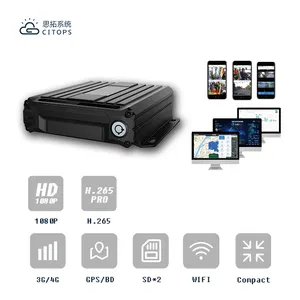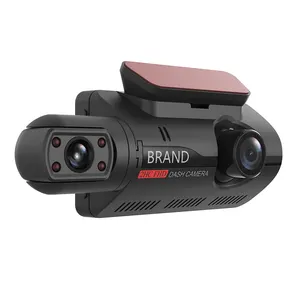
All categories
Featured selections
Trade Assurance
Buyer Central
Help Center
Get the app
Become a supplier

(12797 products available)














































There are several types of Digital Video Recorders (DVRs), and differences in the function of DVRs lead to applications in different areas.
SDVRs (Standard Digital Video Recorders)
SDVRs are the traditional ones that record surveillance footage onto local hard drives. Unlike the contemporary network video recorders that use IP cameras. SDVRs connect to analog cameras and have wallets dedicated to coaxial cable wiring. They are known for their stability and straightforward implementation. Many still use them where legacy surveillance systems operate.
HDVRs (Hybrid Digital Video Recorders)
HDVRs offer the most flexibility. This flexibility comes in because they support both analog and IP cameras. Thus, enabling gradual system upgrades. They maintain local storage like SDVRs, but they also support remote viewing and integration with more advanced features like motion detection. HDVRs are very useful in both environments that are transitional and mixed.
NVRs (Network Video Recorders)
Network Video Recorders are tailored for IP camera-based systems. They record and store footage over a network, offering more flexibility in camera placement and scalability. Many NVRs support features like cloud storage and remote viewing. This has made them popular in contemporary surveillance frameworks.
Cloud DVRs
As the name suggests, they are increasingly popular. They store footage not on local hard drives but in cloud storage. This allows users to access their video feeds from anywhere, on any device. Cloud DVRs offer easy scalability and reduce the dependence on local infrastructure. However, the long-term costs of cloud storage are higher. This makes them ideal for businesses that value flexibility and mobility.
Portable DVRs
These are compact and designed for mobile use. This feature makes them different from the others. Such DVRs are mainly used in law enforcement. They are worn by officers' body cameras. They provide real-time recording and often come with built-in storage. Their size and functionality make them extremely useful for recording events on the go.
A lot of people are attracted to the archival function of DVRs. That is because they provide a critical layer of security for businesses. Thus, enabling users to manage, store, and retrieve video footage with ease.
At first, the mainstay of these systems was surveillance. Today, however, they have evolved to serve a variety of business-related functions. One of the new features that have been added is the ability to integrate seamlessly with IP cameras for enhanced recording and streaming capabilities.
Investing in quality DVRs means that businesses can effectively safeguard their premises and valuable assets. Added benefits include reducing the crime risk, optimizing operational efficiencies, and facilitating the resolution of disputes through detailed video documentation.
Upgrading to advanced systems improves the overall quality of these recordings, such as recording in real time, and capturing critical moments with greater clarity.
Some of the new features that have been added to contemporary DVRs include remote access and mobile viewing. This allows users to monitor activities from anywhere, providing flexibility and real-time oversight. Intuitive interfaces also make it easier to review footage for quick responses to incidents or routine check-ups.
Moreover, many modern DVRs offer cloud storage options. This enhances the security of the recorded footage and prevents loss in case of damage to the physical device. Not to mention, this feature allows for the easy sharing of video clips when needed.
The market for commercial DVRs is expected to grow since it addresses the needs of various sectors, such as retail, hospitality, and transportation. These industries use surveillance systems for security and operational monitoring purposes.
Features such as multi-camera support, long storage capacity, and user-friendly search functions are invaluable to these businesses. Thus meeting their diverse needs, commercial DVRs have become integral in enhancing security, optimizing operations, and providing peace of mind to business owners.
An effective user interface is important for the seamless operation of DVRs since it reduces the complexity associated with surveillance tasks. The layout is usually very intuitive, which allows users to navigate through various functions such as live viewing, playback, and settings without requiring much training.
Most contemporary DVRs are equipped with a graphical interface that supports mouse and remote control navigation. Through sections like 'Live' or 'Playback,' users can switch between multiple camera feeds with ease. There are also shortcuts for tags and zooming to enhance this process.
Moreover, many systems use a feature called thumbnail search. With thumbnail search, users can quickly locate specific events by browsing through snapshot previews rather than scrolling through hours of footage.
Integration with mobile devices has also been a significant advancement. Many modern DVRs offer mobile applications that allow users to access live feeds and recorded footage directly from their smartphones or tablets. This feature brings surveillance to a more portable and user-friendly format.
As noted earlier, remote viewing capabilities significantly improve the system's effectiveness. It allows users to monitor multiple locations in real time. This is especially very useful for businesses that need to keep an eye on different areas like retail stores, warehouses, or offices.
Beyond just security, a good interface also enhances operational efficiency. For instance, a transportation company using a DVR to monitor bus fleets can quickly check on drivers or traffic conditions. The time saved with fast navigation and searching directly translates into more efficient business operations.
In essence, a well-designed interface bridges complex surveillance technology and user needs. By making it easy to control and access recorded video, businesses can better meet their security and operational requirements.
When selecting an appropriate DVR for one’s business, there is a need to consider several key factors to ensure the chosen system meets operational needs.
Start by assessing the scale of the desired surveillance. How many camera feeds will the system be expected to handle? How much storage will be needed? While single-location businesses may only need a few camera connections, multi-site operations may require a system capable of supporting dozens of feeds. Choosing a solution that seamlessly scales with future growth is also important.
Next, focus on recording quality and storage capacity. For clear, detailed footage, it is essential to have a good resolution, especially for areas like retail floors or loading docks. Look for DVRs with ample storage, either on-premises or cloud-based, to handle extended periods of recorded video.
Then consider the user experience. Is the interface easy to navigate for staff? Will it allow quick access to live or recorded footage in emergencies? Intuitive controls and search functions can save crucial minutes during incidents.
Finally, reliability is a critical function. A system that fails means there would be no security coverage. Opt for proven, durable brands. This type of DVR can withstand the demands of always-on surveillance. It is also worth checking what technical support or warranty options are available for the system.
One can ensure enhanced security and peace of mind by carefully considering the scale, recording quality, user experience, and reliability when choosing a DVR. A good understanding of these factors leads to optimizing operational needs, costs, and efficiency.
A1. A Digital Video Recorder primarily functions to record and store video footage for surveillance purposes. It enables users to playback, pause, and review recorded events. This provides critical support for security monitoring and incident analysis.
A2. Accessing recorded footage is usually done through the DVR's interface, where users can navigate to the desired time or event to playback. Some systems also offer advanced search features to make this process faster and more efficient.
A3. Yes. There are Standard DVRs for analog systems and Network Video Recorders for IP camera setups. Hybrid DVRs are also available to support both types of cameras. Each option is tailored to specific surveillance requirements, thus ensuring flexibility and scalability.
A4. Storage determines how long the recorded footage can be retained. Larger storage capacities enable the longer retention of videos, which is helpful for security reviews or legal inquiries. It ensures that critical footage is not overwritten before it can be needed.
A5. Not all DVRs have remote viewing capability. However, many contemporary models include this feature. It allows real-time monitoring from mobile devices or computers, thus providing greater flexibility in managing surveillance from anywhere.